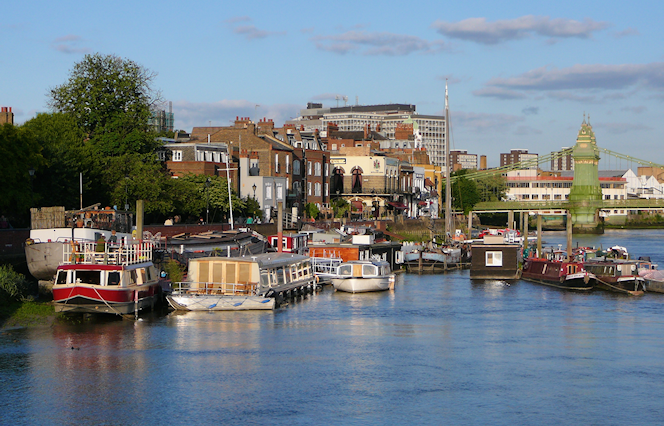Hammersmith
Hammersmith, Hammersmith & Fulham
A strategically significant commercial and cultural centre located on the north bank of the Thames one-and-a-half miles west of Kensington

Prehistoric pottery, flints and a leaf-shaped arrowhead have been found on the embankment and there is also evidence of Roman habitation. Hammersmith developed as a Saxon fishing village and its name (which probably refers to the presence of a hammer smithy or forge) was first recorded in 1294.
A foreshore of gravel, rather than the more common marsh, made Hammersmith a healthy retreat for jaded Londoners from the Middle Ages onwards and a chapel of ease, later St Paul’s church, was built in 1631. Further west, boat builders, lead mills and malthouses clustered around the outlet of Stamford Creek into the Thames.
Catherine of Braganza, queen consort of Charles II, came to live on Upper Mall in 1687 after she was widowed, and several fine villas were later built by the river here. A ribbon of houses flanked the road to London by the early 19th century and Hammersmith Bridge opened in 1827, stimulating development on both sides of the river. Hammersmith gained parochial independence from Fulham in 1834.
Away from the riverside, a poverty-stricken settlement evolved at Brook Green during the mid-19th century, since when its reputation has risen considerably. The Hammersmith and City Railway arrived in 1864. In the late 19th century King Street became the district’s main shopping centre and the Metropolitan Board of Works opened Ravenscourt Park to the public.
Much of Hammersmith’s architectural heritage was lost in the middle decades of the 20th century as the district became increasingly urbanised but some important examples have survived, especially by the riverside. Subsequent gentrification has rehabilitated Victorian streets such as those in Brackenbury Village.
Hammersmith flyover – dubbed ‘the gateway to west London’ – was built in 1961 and is now overlooked by the Ark, a copper and glass concoction that is among several office blocks in the vicinity of Hammersmith Broadway. This is one of London’s busiest traffic junctions, with a bus and tube interchange and shopping mall at its centre.
Charing Cross hospital moved to its present home on the Fulham Palace Road in 1973. Maggie’s cancer centre, then the first of its kind in England, opened at the hospital in 2008.
Hammersmith has three noteworthy arts and entertainment venues: the Lyric, a 19th-century auditorium and a studio theatre encased in concrete; the Apollo, a former cinema that now hosts major rock gigs and stand-up comedy shows; and the Riverside Studios, a cinema and performing arts venue due to be reincarnated in 2017. Legendary ballroom the Hammersmith Palais closed in 2007 and was demolished in 2012.
The riverbank west of Hammersmith Bridge is lined with long-established inns. The Rutland and Blue Anchor are on Lower Mall, which Nikolaus Pevsner commends as “Hammersmith’s best street” and is shown in the photograph at the top of the page. On Upper Mall, James Thomson wrote the words to ‘Rule Britannia’ in an upstairs room at The Dove. One of its bars is reputed to be Britain’s smallest, with less than 33 square feet of floor space. Beyond the Dove you’ll come to the Old Ship and then the Black Lion before you stumble into Chiswick.
JMW Turner lived on Upper Mall from 1808 to 1814. On the same street, Francis Ronalds invented the electric telegraph in 1816, in the garden of a house in which designer-craftsman William Morris lived from the age of 45 until his death in 1896. Morris called the house Kelmscott after his Oxfordshire home and gave the same name to a publishing firm that he founded. Gustav Holst conducted the Hammersmith socialist choir at Kelmscott and composed an orchestral prelude and scherzo entitled Hammersmith.
The BBC2 sitcom Bottom (1991–5, created by and starring Adrian Edmondson and Rik Mayall) was set in a squalid flat in the fictional Mafeking Parade (or Terrace), Hammersmith. Following Mayall’s untimely death in 2014, a memorial bench was installed at the junction of Queen Caroline Street and Hammersmith Bridge Road.
